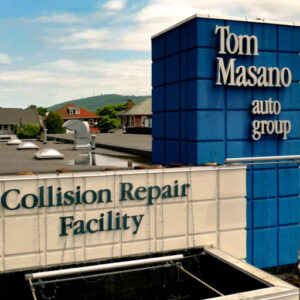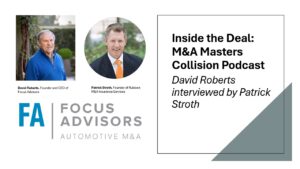This article was originally published by Brian Bradley on Autobody News and is republished here with permission.
The recent interest rate cut by the Federal Reserve could spur more real estate acquisition in the collision repair industry, but it may take months for this and other impacts of the decrease to materialize, according to analysts.
“Interest rate cuts tend to cause capitalization rates to decrease because lower rates can make financing more affordable for investors in commercial properties,” Focus Advisors Senior Associate Madeleine Roberts Rich told Autobody News. “More affordable financing drives up valuations.”
The Fed cut interest rates by 0.5 percentage points to between 4.75% and 5% on Sept. 18, the first cut since March 2020. The action may signal more repair shop expansion and investments on the horizon.
But Rich cautioned it can take a long time for business owners to plan and find financing for major investments such as real estate purchases or business acquisitions. “It certainly does not happen overnight,” she said.
It can take a while for other industries to respond to interest rate shifts as well. For instance, experts expect the Fed rate cut won’t create significant effects in the manufacturing industry until January, spurred in part by an anticipated spike in consumer sentiment as credit card interest rates come down, according to a Sept. 19 article in Manufacturing Dive.
Analysts noted many of the Fed rate cut’s impacts on collision repair industry investments are uncertain writ large. Still, analysts envision a few potential outcomes.
Real Estate Investments
Rich said she believes the most significant impacts of the Fed rate cut will be on landlords who own shops occupied by consolidators.
Fed rate cuts generally coincide with real estate capitalization rate decreases, as borrowing costs for real estate become more affordable, she noted.
“If they own a property where Caliber is the tenant or Gerber’s the tenant or Crash Champions is the tenant, the cap rate on their property’s going to go down a good amount,” Rich said. “Or, if they’re considering … an entry into a lease with that consolidator, they’re going to benefit from the lower cap rates as well.”
Scott Gould, senior vice president of investments at real estate investment brokerage firm Marcus & Millichap, said the Fed rate cut will likely propel “a little bit more” real estate investment in the collision repair industry. “There’s still a lot of money on the sidelines just waiting to feel what’s going to happen next,” he said. “There’s that pent-up demand.”
With the rate cut, it could make more sense for high-leverage real estate investors in the collision sphere to snap up more real estate, Gould said. “I’m optimistic that that will kick up more activity from passive investors looking to buy body shop properties as income streams,” he said. However, current construction costs may not yet be conducive to a sustainable greenfield strategy.
National construction costs were about 27% higher in the second quarter of 2024 than in 2019, the last full year prior to the COVID-19 pandemic, according to the most recent Overall Construction Cost Index by construction and real estate development firm Mortenson.
Gould cited some remaining stagnation in the market. Loans aren’t as cheap as they were three or four years ago, which has made financing these investments a lot less attractive.
“The buyers that want to see an adjustment in pricing that haven’t really gotten that from the sellers, so there’s that delta between expectations, which has slowed transactions,” Gould said.
Shop Consolidations
Though the Fed rate cut could catalyze some additional borrowing in the collision repair space, specifically for real estate, analysts believe it’s unlikely the move will directly spark new company acquisitions.
Multi-shop operators (MSOs) have sought out some debt to drive their acquisitions during the 2020-2024 period of higher interest rates, but the industry can view debt-infused transactions as a gamble, according to Focus Advisors President Chris Lane.
“First of all, it’s expensive,” he said. “Second of all, it’s risky.”
The disincentives of seeking debt, continuing high industrywide business valuations, and ongoing robust competition mean a rate shift in and of itself isn’t likely to sway consolidations one way or the other, Lane said. “I don’t think that the cost of capital is going to influence the rate of consolidation,” he said. “It’s going to continue at the rate that it is. There’s just too much competition for shops that I don’t think the macro picture interest rates are going to matter that much.”
However, outside investors, such as private equity firms that acquire smaller mom-and-pop shops and MSOs, commonly use some bank debt alongside their existing equity to buy those shops and MSOs, Lane said.
Higher interest rates during the last four years have translated to banks scrutinizing private equity firms’ financials a bit more, and spending more time in vetting deals they lend for, he added. So, if more capital opens, collision repair companies’ valuations could potentially see a modest uptick above their already strong levels.
Focus Advisors is a mergers and acquisitions (M&A) advisory firm for collision repair businesses looking to sell or acquire capital to grow. The firm represents the owners, not buyers, and has closed more than 30 MSO acquisitions.
Bank Interest Rates
Gould said he has already seen lenders start to quote lower interest rates in response to the Fed rate cut.
As of late September, some lenders were considering putting a floor on their five-year adjustments because they don’t know how low interest rates will go, he said.
“They don’t want to do a loan today at 6.5 [percent], and then [the Fed rate] goes back down to 4 [percent], and then they get readjusted much further south,” Gould said.
That said, not all interest rates have responded to the rate cut yet, he added. Lenders are all over the board.
Common real estate projects in the collision repair space, such as greenfield and brownfield investments, are generally more reliant on longer-term fixed rates than they are on banks’ prime rates, Paul Knowlton, equipment finance sales executive for The Huntington National Bank, told Autobody News.
Banks’ prime rates are more closely tied to the federal funds rate. “Prime doesn’t lower the 10-year cost of money by half a point,” Knowlton said. “But in general, it’s trending the right way, and expectations are for rates to continue to drop and the yield curve to be normalized.” Knowlton emphasized his opinions were only his, and not Huntington Bank’s.
A Sept. 23 Huntington Bank report noted longer-run rates have decreased for several months in anticipation of the Fed’s September rate cut, including for auto loans and home mortgages.
Further, the nationwide shift to electric vehicles and batteries is prompting a “boom” in factory construction, which is experiencing its highest spending level in decades, increasing from about $900 billion in 2013 to well over $2 trillion in 2023, according to the Huntington report.
“Rate forecasts are often wrong, so taking advantage of [longer-duration] rates can reduce interest expense volatility and lock in the current outlook,” the report stated.
Political Backdrop
How quickly any macro effects of the Fed rate cut spill into the collision repair industry depend on a range of factors, including the ones described above.
Additionally, despite the rate cut, some financial uncertainty has percolated in the collision repair borrowing space regarding the pending November presidential election, analysts noted.
Companies are waiting to see the fiscal and tax implications of the next administration, according to Lane.
“To people, it feels like, ‘I’m more afraid of who the next administration is going to be, and what’s going to happen to my tax rate,’” Lane said. “They feel more strongly about, ‘What are my cap gains rates; what is that going to look like?’ than they do about interest rates. I think a lot of that is probably driving economic decisions.”
Though the political cycle can damper repair equipment acquisition and expansion decisions, it appears the decreased Fed rate is eliminating some of those headwinds, Knowlton said.
“Anytime there’s an election cycle, there’s uncertainty, and uncertainty isn’t conducive to making future investments, whether it’s buying a business or financing equipment,” he said. Despite election timing, there are “a lot of tax benefits to buying equipment in the fourth quarter.”
Equipment Purchases
To be certified to repair their vehicles, some OEMs require body shops to have specific types of equipment, whether it be certain welders, frame straighteners or measuring systems, to name a few.
Companies may have to invest as much as $50,000 to $150,000 in equipment if they want to work on a particular car brand, Knowlton said.
Buying equipment in the fourth quarter of a calendar year, just before tax season, can bring timely benefits. Internal Revenue Code Section 179 allows businesses to claim lower current-year tax liability for depreciable assets, including equipment, instead of capitalizing an asset and depreciating it over time in future tax years.
“My guess is that the capital equipment people see a pretty good bump here through the year, irrespective of the election,” Knowlton added. Though new equipment — along with real estate — is a major area that collision repairers seek financing for, it can be “hit or miss,” as not every shop feels the need to make frequent or higher-end investments in new equipment, Lane said.
That said, the last time frame the collision repair industry found itself in a lower rate environment — during the heat of COVID in 2020 — shops borrowed substantially, including for equipment investments, Rich said. “They got [Small Business Administration] loans during COVID that when rates were really, really, really low, a lot of collision repair entrepreneurs, fortunately, recognized that this is too good to pass up,” she said. The Federal Funds Rate sat at 0% to 0.25% in March 2020. It didn’t rise until March 2022, to 0.25% to 0.50%.
Even though rates are nowhere near as low as COVID rates, this is the first rate cut in four years, and anytime there’s a business rate cut, it increases business confidence, Knowlton said. “Lowering and decreasing rates creates some certainty, which allows companies to look forward a little further,” he added. “Whether it’s the brownfield investments or investing in equipment or buying that shop in the next town, it just makes that path a little smoother and that decision a little easier to make.
This article was originally published by Autobody News linked here.
About Focus Advisors, Inc.
Focus Advisors (www.focusadvisors.com) is the collision industry’s leading M&A advisory firm, partnering with MSOs between $10-100M in annual revenue, helping owners achieve maximum value through strategic growth and exits. Unlike traditional business brokers or large investment banks, Focus Advisors specializes exclusively in collision repair — giving owners unparalleled insight into value, interest, and opportunity timing. With over 25 years in the industry, Managing Director David Roberts has led more than 40 transactions totaling over $500 million in transaction value and more than 325 collision repair shops, including Pride Auto Body, Quanz Auto Body, Mills Body Shops, and Master Collision Group.
Investment Banking Services and Securities offered through Independent Investment Bankers Corp, a broker-dealer, member FINRA, SIPC. Focus Advisors Automotive M&A is not affiliated with Independent Investment Bankers Corp.






